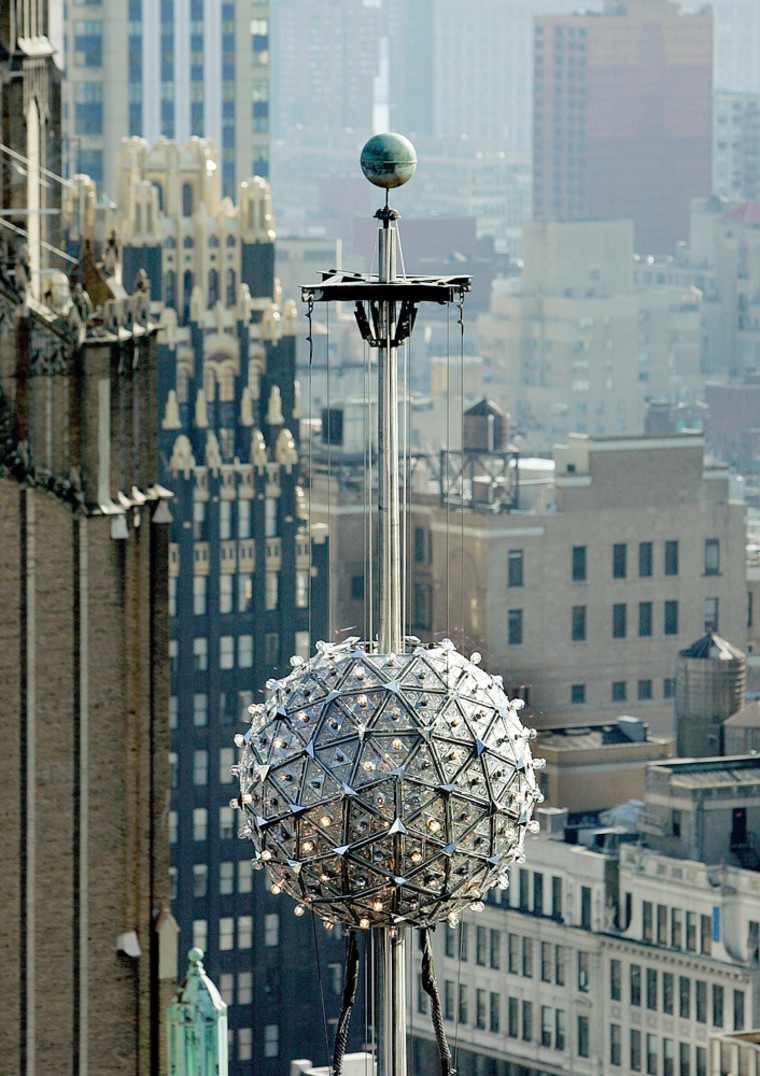At the stroke of midnight on Saturday, close to a billion people will count backward from ten to one, and then it's out with the old and in with the new. But this year, the beloved Times Square New Year's Eve ball is changing, too.
When the brightly illuminated crystal ball slides down the flagpole high atop the One Times Square building in New York City, it will mark the last time the ball is lit exclusively with incandescent lighting. So say good-bye to all those bulbs.
For the New Year Eve 2006/07 celebration, lighting giant Philips Electronics will outfit the ball with an interior of more efficient light-emitting diodes (LEDs). By 2007/08, the entire sphere will be redesigned and completely illuminated by LEDs, making it an even brighter and sparklier beacon for the throngs in Times Square and the millions of TV viewers around the globe.
"We think it is fitting to bring the best and brightest technology to the New Year's ball," said Govi Rao, vice president and general manager of solid-state lighting at Philips North America.
Since they are produced from semiconductor chips — and without glass bulbs or tungsten fibers — LEDs are extremely lightweight and environmentally safe. Also known as solid-state lighting, LEDs produce brighter light with virtually no heat and consume 50% to 70% less energy than conventional lighting. Best of all, they can last between 50,000 and 100,000 hours, whereas conventional incandescent light bulbs have a lifespan of around 1,500 hours.
According to Rao, rewiring the New Year's ball with LEDs is a highly visible way to showcase Philips Electronics' commitment to digital lighting.
"It's an emerging technology," he said. "Projects like refitting the Times Square ball with solid-state technology is not something we look at in terms of profitability but as a way to introduce the technology and to learn along with it."
Though Philips' lighting division accounts for about $6 billion of the $40 billion dollar company, it has invested more than $1 billion in solid-state lighting research and development. "Solid-state lighting is going to become the mainstream of lighting. Therefore we have to invest in it," Rao said
LEDs are already in use in electronics equipment, car lighting, traffic signals and signage —including the majority of the ball's garish ad-display neighbors in Times Square.
Last upgrade was for the millennium
The 1,070 pound geodesic orb, six feet in diameter, is built by Waterford, Ireland-based Waterford Crystal. Philips Electronics provides the crucial 600 clear and colored high-intensity halogen bulbs and 96 halogen strobe lights that currently stud the exterior and interior of the ball and create its dramatic sparkling effect.
The two companies have been in partnership since 2000, when the old New Year's aluminum ball (in use, with periodic upgrades, since 1955) was replaced with the glittering Waterford design.
Jeffrey Straus, president of Countdown Entertainment, the agency that represents the ball's owner, Jamestown One Times Square, a unit of Atlanta-based Jamestown Properties, said he plans the full redesign to coincide with the 2007 centennial celebration of the New Year's Eve ball tradition.
"We're very excited to be going forward with LEDs," he said. "The last big change [to the ball] was for the millennium. It seems appropriate to introduce the new technology for the 100th birthday [of the event]."
Plans for the redesign will be finalized by mid-2006. Rao and Straus said it was too soon to predict costs.
Changes and upgrades to the ball are paid for by sponsors of the Times Square New Year's Eve celebration, which this year include Philips, Waterford Crystal, Coca-Cola, Panasonic and Korbel Champagne. Straus said the 2005 production costs were about $2 million, not including police and sanitation expenses.
"The New Year's ball has always been a combination of tradition and new technology," Straus said. "Back in 1907, when the first ball was designed, electricity was a brand new technology."
Philips will specially engrave and auction off 90 of the soon-to-be-retired New Year's ball halogen light bulbs on eBay after the celebration. All proceeds will be donated to the Red Cross.
